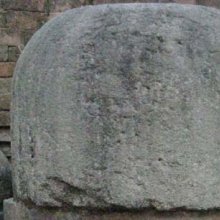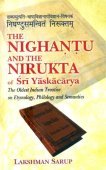Anta, Amta, Aṇṭā, Antā: 29 definitions
Introduction:
Anta means something in Buddhism, Pali, Hinduism, Sanskrit, Jainism, Prakrit, the history of ancient India, Marathi, Hindi, biology, Tamil. If you want to know the exact meaning, history, etymology or English translation of this term then check out the descriptions on this page. Add your comment or reference to a book if you want to contribute to this summary article.
Images (photo gallery)
(+7 more images available)
In Hinduism
Purana and Itihasa (epic history)
Source: Cologne Digital Sanskrit Dictionaries: The Purana IndexAnta (अन्त).—1000 crores×niyuta (1 lakh).*
- * Vāyu-purāṇa 101. 98.

The Purana (पुराण, purāṇas) refers to Sanskrit literature preserving ancient India’s vast cultural history, including historical legends, religious ceremonies, various arts and sciences. The eighteen mahapuranas total over 400,000 shlokas (metrical couplets) and date to at least several centuries BCE.
Vyakarana (Sanskrit grammar)
Source: Wikisource: A dictionary of Sanskrit grammarAnta (अन्त).—Final, phonetically last element remaining, of course, after the mute significatory letters have been dropped. cf. अनुत्तरलक्षणोन्तः (anuttaralakṣaṇontaḥ) M. Bh. on I. 1.21 Vārt, 6.

Vyakarana (व्याकरण, vyākaraṇa) refers to Sanskrit grammar and represents one of the six additional sciences (vedanga) to be studied along with the Vedas. Vyakarana concerns itself with the rules of Sanskrit grammar and linguistic analysis in order to establish the correct context of words and sentences.
Ganitashastra (Mathematics and Algebra)
Source: archive.org: Hindu MathematicsAnta (अन्त) refers to a “hundred-billion” (100,000,000,000) in various lists of numeral denominations, according to gaṇita (“science of calculation”) and Gaṇita-śāstra, ancient Indian mathematics and astronomy.—We can definitely say that from the very earliest known times, ten has formed the basis of numeration in India. While the Greeks had no terminology for denominations above the myriad (104), and the Romans above the milk (103), the ancient Hindus dealt freely with no less than eighteen denominations [e.g., anta]. Cf. Yajurveda-saṃhitā (Vājasanyī) XVII.2; Taittirīya-saṃhitā IV.40.11, VII.2.20.1; Maitrāyaṇī-saṃhitā II.8.14; Kāṭhaka-saṃhitā XVII.10, XXXIX.6; Anuyogadvāra-sūtra 142; Āryabhaṭīya II.2; Triśatikā R.2-3; Gaṇitasārasaṃgraha I.63-68.

Ganitashastra (शिल्पशास्त्र, gaṇitaśāstra) refers to the ancient Indian science of mathematics, algebra, number theory, arithmetic, etc. Closely allied with astronomy, both were commonly taught and studied in universities, even since the 1st millennium BCE. Ganita-shastra also includes ritualistic math-books such as the Shulba-sutras.
Yoga (school of philosophy)
Source: ORA: Amanaska (king of all yogas): A Critical Edition and Annotated Translation by Jason BirchAnta (अन्त) refers to “destruction”, according to verse 10.16 of Sureśvarācārya’s Mānasollāsa.—Accordingly, “By merely his own will, [the Yogin] is the agent of creation, preservation and destruction (anta) of worlds [lokānāṃ sṛṣṭisthityantakartṛtā] and the master of the sun and so on. This is called [the Siddhi of] sovereignty”.

Yoga is originally considered a branch of Hindu philosophy (astika), but both ancient and modern Yoga combine the physical, mental and spiritual. Yoga teaches various physical techniques also known as āsanas (postures), used for various purposes (eg., meditation, contemplation, relaxation).
In Buddhism
Mahayana (major branch of Buddhism)
Source: Wisdom Library: Maha Prajnaparamita SastraAnta (अन्त) is Pali for “intestines” (Sanskrit Antra) refers to one of the thirty-substances of the human body according to the Visuddhimagga, as mentioned in an appendix of the 2nd century Mahāprajñāpāramitāśāstra chapter 32-34. The Mahāprajñāpāramitāśāstra mentions thirty-six substances [viz., anta]; the Sanskrit sources of both the Lesser and the Greater Vehicles, physical substances are 26 in number while the Pāli suttas list thirty-once substances.
Source: academia.edu: A Study and Translation of the Gaganagañjaparipṛcchā1) Anta (अन्त) refers to the “extremes”, according to the Gaganagañjaparipṛcchā: the eighth chapter of the Mahāsaṃnipāta (a collection of Mahāyāna Buddhist Sūtras).—Accordingly, “[...] The Bodhisattva Gaganagañja then sustained the jewel-canopy of ten thousand yojanas high over the Lord’s lion throne in the sky, joined the palms of his hands, saluted, and praised the Lord with these suitable verses: ‘[...] (9) Without discrimination (vikalpa) eliminating the middle (madhya) and the extremes (anta), [you understand] emptiness that all has a trifling intrinsic nature, is worthless and void. Though, knowing the complete purity of such dharmas, you explain cause and action to living beings. [...]”.
2) Anta (अन्त) or Antadṛṣṭi refers to an “extreme view”, according to the Gaganagañjaparipṛcchā.—Accordingly, “[...] What then are extreme views (antadṛṣṭi)? ‘Extreme (anta)’ means discontinuity (uccheda) and continuity (nitya), and that which is not originated and ceased is beyond discontinuity and continuity and thus pure, and therefore it is purified when concerned with any extreme view. In that way, son of good family, the Bodhisattva becomes skilled in knowing the entrance into the dependent origination and free from any extreme view”.

Mahayana (महायान, mahāyāna) is a major branch of Buddhism focusing on the path of a Bodhisattva (spiritual aspirants/ enlightened beings). Extant literature is vast and primarely composed in the Sanskrit language. There are many sūtras of which some of the earliest are the various Prajñāpāramitā sūtras.
Tibetan Buddhism (Vajrayana or tantric Buddhism)
Source: academia.edu: A Critical Study of the Vajraḍākamahātantrarāja (II)Anta (अन्त) is the name of a Vākchomā (‘verbal secrect sign’) which has its meaning defined as ‘caṇḍāla’ according to chapter 8 of the 9th-century Vajraḍākamahātantrarāja, a scripture belonging to the Buddhist Cakrasaṃvara (or Saṃvara) scriptural cycle. These Vākchomās (viz., anta) are meant for verbal communication and can be regarded as popular signs, since they can be found in the three biggest works of the Cakrasaṃvara literature.

Tibetan Buddhism includes schools such as Nyingma, Kadampa, Kagyu and Gelug. Their primary canon of literature is divided in two broad categories: The Kangyur, which consists of Buddha’s words, and the Tengyur, which includes commentaries from various sources. Esotericism and tantra techniques (vajrayāna) are collected indepently.
In Jainism
General definition (in Jainism)
Source: SOAS Research Online: Prekṣā meditation: History and MethodsAnta (अन्त) refers to “finite”; as opposed to Ananta—“infinite” which refers to one of the 46 qualities of the soul to be meditated on in the “Practice of Meditation on Liberated Souls (Siddhas)”, according to Jain texts like Ācārāṅga (5.6.123-140), Ṣaṭkhaṇḍāgama (13.5.4.31) and Samayasāra (1.49).—The pure soul can be recognised by meditation on its true nature, represented by the liberated souls of the Siddhas. [...] The qualities of the soul to be meditated on as truly mine are: [e.g., My soul is infinite (an-anta)] [...] The meditation on such extended fourty-five qualities of the pure soul presents the niśacaya-naya, which is aligned with Kundakunda’s approach.

Jainism is an Indian religion of Dharma whose doctrine revolves around harmlessness (ahimsa) towards every living being. The two major branches (Digambara and Svetambara) of Jainism stimulate self-control (or, shramana, ‘self-reliance’) and spiritual development through a path of peace for the soul to progess to the ultimate goal.
India history and geography
Source: Cologne Digital Sanskrit Dictionaries: Indian Epigraphical GlossaryAnta.—(IE 8-4; CII 1), a state beyond the borders of one's territeries, or a bordering district; also its people; cf. pratyanta. (CII 1), cf. Anta-mahāmātra, officer employed in districts bordering on the frontiers of one's kingdom. (EI 3), a neighbour. Note: anta is defined in the “Indian epigraphical glossary” as it can be found on ancient inscriptions commonly written in Sanskrit, Prakrit or Dravidian languages.

The history of India traces the identification of countries, villages, towns and other regions of India, as well as mythology, zoology, royal dynasties, rulers, tribes, local festivities and traditions and regional languages. Ancient India enjoyed religious freedom and encourages the path of Dharma, a concept common to Buddhism, Hinduism, and Jainism.
Biology (plants and animals)
Source: Google Books: CRC World Dictionary (Regional names)Anta in Philippines is the name of a plant defined with Vigna unguiculata in various botanical sources. This page contains potential references in Ayurveda, modern medicine, and other folk traditions or local practices It has the synonym Phaseolus sphaerospermus L. (among others).
Example references for further research on medicinal uses or toxicity (see latin names for full list):
· Mémoires de l’Institut Égyptien (1889)
· Catalogus Plantarum in Horto Botanico Bogoriensi Cultarum Alter (1844)
· Flora Indica (1768)
· Linnaea (1839)
· Repertorium Botanices Systematicae (1843)
· Plantae Javanicae Rariores (1848)
If you are looking for specific details regarding Anta, for example extract dosage, side effects, pregnancy safety, health benefits, chemical composition, diet and recipes, have a look at these references.

This sections includes definitions from the five kingdoms of living things: Animals, Plants, Fungi, Protists and Monera. It will include both the official binomial nomenclature (scientific names usually in Latin) as well as regional spellings and variants.
Languages of India and abroad
Pali-English dictionary
Source: BuddhaSasana: Concise Pali-English Dictionaryanta : (m.) the end; goal; top. nt. intestine.
Source: Sutta: The Pali Text Society's Pali-English Dictionary1) Anta, 3 (nt.) (Vedic āntra, contr. fr. antara inner = Lat. interus, Gr. e)/ntera intestines) the lower intestine, bowels, mesentery It.89; J.I, 66, 260 (°vaddhi-maṃsa etc.); Vism.258; DhA.I, 80.
2) Anta, 2 (adj.) (Vedic antya) 1. having an end, belonging to the end; only in neg. ananta endless, infinite, boundless (opp. antavant); which may be taken as equal to anta1 (corresp. with Sk. anta (adj.) or antya; also in doublet anañca, see ākās’ânañca and viññāṇ’ânañca); D.I, 23, 34 = D.III, 224, 262 sq.; Sn.468 (°pañña); Dh.179, 180 (°gocara having an unlimited range of mental vision, cp. DhA.III, 197); J.I, 178. — 2. extreme, last, worst J.II, 440 (C. hīna, lāmaka); see also anta1 4. — Acc. as adv. in ekantaṃ extremely, very much, “utterly” Dh.228 etc. See eka. (Page 47)
3) Anta, 1 (Vedic anta; Goth. andeis = Ohg. anti = E. end; cp. also Lat. antiae forehead (: E. antler), and the prep. anti opposite, antika near = Lat. ante; Gr. a)nti/ & a)/nta opposite; Goth., Ags. and; Ger. ant-; orig. the opposite (i. e. what stands against or faces the starting-point)). 1. end, finish, goal S.IV, 368 (of Nibbāna); Sn.467; J.II, 159. antaṃ karoti to make an end (of) Sn.283, 512; Dh.275, cp. antakara, °kiriyā. — Loc. ante at the end of, immediately after J.I, 203 (vijay°). — 2. limit, border, edge Vin.I, 47; Dh.305 (van°); J.III, 188. — 3. side: see ekamantaṃ (on one side, aside). — 4. opposite side, opposite, counterpart; pl. parts, contrasts, extremes; thus also used as “constituent, principle” (in tayo & cattāro antā; or does it belong to anta2 2. in this meaning? Cp. ekantaṃ extremely, under anta2): dve antā (two extremes) Vin.I, 10; S.II, 17; III, 135. ubho antā (both sides) Vin.I, 10; S.II, 17; J.I, 8; Nd1 109. eko, dutiyo anto (contrasts) Nd1 52. As tayo antā or principles(?), viz. sakkāya, s.-samudaya, s.-nirodha D.III, 216, cp. A.III, 401; as cattāro, viz. the 3 mentioned plus s.-nirodhagāmini-paṭipadā at S.III, 157. Interpreted by Morris as “goal” (J P T S. 1894, 70). — Often pleonastically, to be explained as a “pars pro toto” figure, like kammanta (q. v.) the end of the work, i. e. the whole work (cp. E. sea-side, country-side); vananta the border of the wood = the woods Dh.305; Pv.II, 310 (explained by vana PvA.86; same use in BSk., vanânta e. g. at Jtm VI, 21; cp. also grāmânta Av. Ś. I.210); suttanta (q. v.), etc. Cp. ākāsanta J.VI, 89 & the pleonastic use of patha. —ananta (n.) no end, infinitude; (adj.) endless, corresponds either to Sk. anta or antya, see anta2.

Pali is the language of the Tipiṭaka, which is the sacred canon of Theravāda Buddhism and contains much of the Buddha’s speech. Closeley related to Sanskrit, both languages are used interchangeably between religions.
Marathi-English dictionary
Source: DDSA: The Molesworth Marathi and English Dictionaryanta (अंत).—m (S) End, termination, conclusion. 2 Death. 3 In nidāna or pathology. The fifth division of disease;--result or issue (i. e. recovery or death). 4 In arith. or geo. The last term of a series. 5 fig. End, reach, depth, bottom, extreme capability. Ex. kōṇhācā anta pāhilyāvāṃ- cūna dēva kōṇhāvara kṛpā karīta nāhīṃ; tyā ghōḍyācā anta pāhūna dāhā kōsa nyā. anta pāhaṇēṃ therefore is To try to the uttermost; to see how much can be done or borne. Ex. saṃsārīṃ nakō harī mājhā anta pāhūṃ 6 Remaining strength, stamina, substance, goodness. Ex. tyā dhōtarānta kāṃhīṃ anta rāhilā nāhīṃ.
--- OR ---
anta (अंत).—prep (S) In comp. As far as; to or unto. Ex. hyānēṃ bhāṣyānta vyākaraṇa āṇi gadādharyanta nyāya mhaṭalā āhē.
--- OR ---
ānta (आंत).—ad & prep (antaḥ S) In or within; inside or inside of. 2 Within a given date; before. 3 In, amongst, together with, inclusively: also in connection with; in the train or wake of; subordinately. Ex. kāmānta kāma-gōṣṭīnta gōṣṭa-kharcānta kharca- karjānta karja-udimānta udīma-pōṭānta pōṭa-karaṇēṃ-cālaviṇēṃ &c. To do, perform, provide for &c. several things at once, or a minor thing in subjection to a main thing. ānta madhyēṃ (Incorrect, but constantly occurring amongst the vulgar.) In the inside. ānta bāhēra karaṇēṃ or pāhaṇēṃ To look inwards and outwards; to observe, consider, and ponder. ānta yēṇēṃ To be contracted or diminished--a business, funds, means.
--- OR ---
ānta (आंत).—n āntaḍī f āntaḍēṃ n (antra S) An entrail or intestine. See antaḍēṃ.
Source: DDSA: The Aryabhusan school dictionary, Marathi-Englishanta (अंत).—m End; death. prep Unto. anta pahāṇēṃ Try to the uttermost.
--- OR ---
ānta (आंत).—ad & prep In, within; before. ānta- cā a Inner.
--- OR ---
ānta (आंत).—n ātaḍīṃ f āntaḍēṃ n An entrail.
Marathi is an Indo-European language having over 70 million native speakers people in (predominantly) Maharashtra India. Marathi, like many other Indo-Aryan languages, evolved from early forms of Prakrit, which itself is a subset of Sanskrit, one of the most ancient languages of the world.
Sanskrit dictionary
Source: DDSA: The practical Sanskrit-English dictionaryAnta (अन्त).—a. [am-tan Uṇādi-sūtra 3.86]
1) Near.
2) Last.
3) Handsome, lovely; Meghadūta 23; दन्तोज्ज्वलासु विमलोपलमे- खलान्ताः (dantojjvalāsu vimalopalame- khalāntāḥ) Śiśupālavadha 4.4, (where, however, the ordinary sense of 'border' or 'skirt' may do as well, though Malli. renders anta by ramya, quoting the authority of śabdārṇava 'mṛtāvavasite ramye samāptāvanta iṣyate').
4) Lowest, worst.
5) Youngest.
-taḥ (n. in some senses)
1) (a) End, limit, boundary (in time or space); final limit, last or extreme point; स सागरान्तां पृथिवीं प्रशास्ति (sa sāgarāntāṃ pṛthivīṃ praśāsti) H.4.5 bounded by the ocean, as far as the sea; अपाङ्गौ नेत्रयो- रन्तौ (apāṅgau netrayo- rantau) Ak.; उद्युक्तो विद्यान्तमधिगच्छति (udyukto vidyāntamadhigacchati) H.3.114 goes to the end of, masters completely; श्रुतस्य यायादयमन्तमर्भकस्तथा परेषां युधि चेति पार्थिवः (śrutasya yāyādayamantamarbhakastathā pareṣāṃ yudhi ceti pārthivaḥ) (where anta also means end or destruction); जीवलोकसुखानामन्तं ययौ (jīvalokasukhānāmantaṃ yayau) K.59 enjoyed all worldly pleasures; आलोकितः खलु रमणीयानामन्तः (ālokitaḥ khalu ramaṇīyānāmantaḥ) K.124 end, furthest extremity; दिगन्ते श्रूयन्ते (digante śrūyante) Bv.1.2.
2) Skirt, border, edge, precinct; a place or ground in general; यत्र रम्यो वनान्तः (yatra ramyo vanāntaḥ) Uttararāmacarita 2.25 forest ground, skirts of the forest; ओदकान्तात् स्निग्धो जनोऽनुगन्तव्यः (odakāntāt snigdho jano'nugantavyaḥ) Ś.4; उपवनान्तलताः (upavanāntalatāḥ) R.9.35 as far as the borders or skirts; वृत्तः स नौ संगतयोर्वनान्ते (vṛttaḥ sa nau saṃgatayorvanānte) R.2.58,2.19; Meghadūta 23. Upper part (śirobhāga); महा- र्हमुक्तामणिभूषितान्तम् (mahā- rhamuktāmaṇibhūṣitāntam) Rām.5.4.3.
3) End of a texture, edge, skirt, fringe or hem of a garment; वस्त्र° (vastra°); पवनप्रनर्तितान्तदेशे दुकूले (pavanapranartitāntadeśe dukūle) K.9 (by itself in Veda).
4) Vicinity, proximity, neighbourhood, presence; नाधीयीत श्मशानान्ते ग्रामान्ते (nādhīyīta śmaśānānte grāmānte) Ms. 4.116; Y.2.162; जलान्ते छन्दसां कुर्यादुत्सर्गं विधिवद् बहिः (jalānte chandasāṃ kuryādutsargaṃ vidhivad bahiḥ) 1.143; गङ्गाप्रपातान्तविरूढशष्पम् (gaṅgāprapātāntavirūḍhaśaṣpam) (gahvaram) R.2.26; पुंसो यमान्तं व्रजतः (puṃso yamāntaṃ vrajataḥ) P.2.115 going into the vicinity or presence of Yama; अन्योन्यामन्त्रणं यत्स्याज्जनान्ते तज्जनान्तिकम् (anyonyāmantraṇaṃ yatsyājjanānte tajjanāntikam) S. D.; यां तु कुमारस्यान्ते वाचमभाषथास्तां मे ब्रूहि (yāṃ tu kumārasyānte vācamabhāṣathāstāṃ me brūhi) Śat. Br. (These four senses are allied).
5) End, conclusion, termination (opp. ārambha or ādi); सेकान्ते (sekānte) R.1.51; दिनान्ते निहितम् (dinānte nihitam) R.4.1; मासान्ते, पक्षान्ते, दशाहान्ते (māsānte, pakṣānte, daśāhānte) &c.; एकस्य दुःखस्य न यावदन्तं गच्छाम्यहं पारमिवार्णवस्य (ekasya duḥkhasya na yāvadantaṃ gacchāmyahaṃ pāramivārṇavasya) Pañcatantra (Bombay) 2.175; व्यसनानि दुरन्तानि (vyasanāni durantāni) Manusmṛti 7.45; दशान्तमुपेयिवान् (daśāntamupeyivān) R.12.1 going to the end of the period of life (end of the wick); व्यसनं वर्धयत्येव तस्यान्तं नाधिगच्छति (vyasanaṃ vardhayatyeva tasyāntaṃ nādhigacchati) Pañcatantra (Bombay) 2.18; oft. in comp. in this sense, and meaning 'ending in or with', 'ceasing to exist with', 'reaching to the end'; तदन्तं तस्य जीवितम् (tadantaṃ tasya jīvitam) H.1.91 ends in it; कलहान्तानि हर्म्याणि कुवाक्यान्तं च सौहृदम् । कुराजान्तानि राष्ट्राणि कुकर्मान्तं यशो नृणाम् (kalahāntāni harmyāṇi kuvākyāntaṃ ca sauhṛdam | kurājāntāni rāṣṭrāṇi kukarmāntaṃ yaśo nṛṇām) || Pañcatantra (Bombay) 5.76; विशाखान्ता गता मेघा प्रसूत्यन्तं च यौवनम् । प्रणामान्तः सतां कोपो याचनान्तंहि गौरवम् (viśākhāntā gatā meghā prasūtyantaṃ ca yauvanam | praṇāmāntaḥ satāṃ kopo yācanāntaṃhi gauravam) || Subhā. फलोदयान्ताय तपःसमाधये (phalodayāntāya tapaḥsamādhaye) Kumārasambhava 5.6 ending with (lasting till) the attainment of fruit; यौवनान्तं वयो यस्मिन् (yauvanāntaṃ vayo yasmin) Kumārasambhava 6.44; R.11.62,14.41; विपदन्ता ह्यविनीतसंपदः (vipadantā hyavinītasaṃpadaḥ) Kirātārjunīya 2.52; युगसहस्रान्तं ब्राह्मं पुण्यमहर्विदुः (yugasahasrāntaṃ brāhmaṃ puṇyamaharviduḥ) Manusmṛti 1.73 at the end of 1 Yugas; प्राणान्तं दण्डम् (prāṇāntaṃ daṇḍam) Manusmṛti 8.359 capital punishment (such as would put an end to life).
6) Death, destruction; end or close of life; धरा गच्छत्यन्तं (dharā gacchatyantaṃ) Bhartṛhari 3.71 goes down to destruction; योगेनान्ते तनुत्यजाम् (yogenānte tanutyajām) R.1.8; एका भवेत्स्वस्तिमती त्वदन्ते (ekā bhavetsvastimatī tvadante) 2.48;12.75; ममाप्यन्ते (mamāpyante) Ś.6; अद्य कान्तः कृतान्तो वा दुःखस्यान्तं करिष्यति (adya kāntaḥ kṛtānto vā duḥkhasyāntaṃ kariṣyati) Udb.; औषध्यः फलपाकान्ताः (auṣadhyaḥ phalapākāntāḥ) Manusmṛti 1.46; अन्तं या (antaṃ yā) To be destroyed, perish, be ruined.
7) (In gram.) A final syllable or letter of a word; अजन्त (ajanta) ending in a vowel; so हलन्त, सुबन्त, तिडन्त (halanta, subanta, tiḍanta) &c.
8) The last word in a compound.
9) Ascertainment, or settlement (of a question); definite or final settlement; pause, final determination, as in सिद्धान्त (siddhānta); न चैव रावणस्यान्तो दृश्यते जीवितक्षये (na caiva rāvaṇasyānto dṛśyate jīvitakṣaye) Rām.6.17.58 उभयोरपि दृष्टोन्तस्त्वनयोस्तत्त्वदर्शिभिः (ubhayorapi dṛṣṭontastvanayostattvadarśibhiḥ) Bhagavadgītā (Bombay) 2.16 (sadasatoḥ ityarthaḥ).
1) The last portion or the remainder (n. also); निशान्तः (niśāntaḥ); वेदान्तः (vedāntaḥ) &c. वेदांश्चैव तु वेदाङ्गान् वेदान्तानि तथा स्मृतीः । अधीत्य ब्राह्मणः पूर्वं शक्तितोऽन्यांश्च संपठेत् (vedāṃścaiva tu vedāṅgān vedāntāni tathā smṛtīḥ | adhītya brāhmaṇaḥ pūrvaṃ śaktito'nyāṃśca saṃpaṭhet) || Bṛhadyogiyājñavalkya Smṛti 12.34.
11) Underneath, inside, inner part; युष्मदीयं च जलान्ते गृहम् (yuṣmadīyaṃ ca jalānte gṛham) Pañcatantra (Bombay) 4 in water, underneath water; सुप्रयुक्तस्य दम्भस्य ब्रह्माप्यन्तं न गच्छति (suprayuktasya dambhasya brahmāpyantaṃ na gacchati) Pañcatantra (Bombay) 1.22 does not penetrate or dive into, sound, fathom; आशङ्कितस्यान्तं गच्छामि (āśaṅkitasyāntaṃ gacchāmi) M.3 shall dive deep into, fully satisfy, my doubts.
12) Total amount, whole number or quantity.
13) A large number.
14) Nature, condition; sort, species; मम मोक्षस्य कोऽन्तो वै ब्रह्मन्ध्यायस्व वै प्रभो (mama mokṣasya ko'nto vai brahmandhyāyasva vai prabho) Mahābhārata (Bombay) 12.282.32. एतदन्तास्तु गतयो ब्रह्माद्याः समुदाहृताः (etadantāstu gatayo brahmādyāḥ samudāhṛtāḥ) Manusmṛti 1.5.
15) Disposition; essence; शुद्धान्तः (śuddhāntaḥ)
16) Division (vibhāga); तेऽनया कात्यायन्याऽन्तं करवाणीति (te'nayā kātyāyanyā'ntaṃ karavāṇīti) Bri. Up.2.4.1. [cf. Goth. andeis, and; Germ. ende and ent; also Gr. anti; L. ante]. cf. अन्तस्तु भागेऽ- वसिते रचनायां च तत्परे । मृतौ निषेवणे रम्ये समाप्तावग्रमध्ययोः ॥ स्वरूपे च समीपे च पुंलिङ्गेऽपि प्रकीर्तितः (antastu bhāge'- vasite racanāyāṃ ca tatpare | mṛtau niṣevaṇe ramye samāptāvagramadhyayoḥ || svarūpe ca samīpe ca puṃliṅge'pi prakīrtitaḥ) | Nm.
--- OR ---
Ānta (आन्त).—a. (-ntī f.) [अन्त-अण् (anta-aṇ)] Final, terminal.
-ntam ind. Completely, to the end; Mahābhārata 4.
Source: Cologne Digital Sanskrit Dictionaries: Edgerton Buddhist Hybrid Sanskrit DictionaryAnta (अन्त).—m. (= Pali id., see Critical Pali Dictionary 3), contrasting principle or opinion: anta-samudāhāraḥ Mūla-Sarvāstivāda-Vinaya i.221.8 (here, discus- sion as to whether Buddha and his order were greedy or not).
--- OR ---
Ānta (आन्त).—adj. (cited in MW without reference; not in [Boehtlingk and Roth] or [Boehtlingk] or Schmidt; Sanskrit back-formation, or error, based on Pali anta = Sanskrit antya; compare antaka), ultimate, final, extreme, supreme: Kāraṇḍavvūha 89.6 āntas tvaṃ kulaputra kṛtas te sattvaparīpākaḥ, you are a supreme one… (it would seem more natural, if only tvaṃ were omitted, to make āntas agree with sattvaparīpākaḥ; perhaps the passage is corrupt).
Source: Cologne Digital Sanskrit Dictionaries: Shabda-Sagara Sanskrit-English DictionaryAnta (अन्त).—mn.
(-ntaḥ-ntaṃ) 1. End, term. 2. Final, ultimate, (continuing M. N. even with a fem. noun.) mfn.
(-ntaḥ-ntā-ntaṃ) 1. Near. 2. Handsome. m. (-nta) 1. Death. 2. A boundary, a limit. 3. Certainty, ascertainment. 4. A limb, a member. n.
(-ntaṃ) Nature, diposition. E. ama to go, and tan Unadi aff.
--- OR ---
Ānta (आन्त).—mfn.
(-ntaḥ-ntā-ntaṃ) Gone. E. am to go, kta aff.
--- OR ---
Ānta (आन्त).—mfn.
(-ntaḥ-ntī-ntaṃ) Final, terminal, relating to the end. E. anta and aṇ aff.
Source: Cologne Digital Sanskrit Dictionaries: Benfey Sanskrit-English DictionaryAnta (अन्त).—m. 1. End, [Nala] 22, 4. 2. Boundary, [Rāmāyaṇa] 3, 15, 16. 3. Limit, [Rāmāyaṇa] 3, 1, 23. 4. Border, [Rāmāyaṇa] 4, 6, 16. 5. Proximity, [Mānavadharmaśāstra] 4, 116. 6. Death, Rām, 5, 87, 29.
Source: Cologne Digital Sanskrit Dictionaries: Cappeller Sanskrit-English DictionaryAnta (अन्त).—[masculine] ([neuter]) end (in space), limit, border, hem (of a garment), vicinity, proximity; end (in time), issue, event; end of life, death; conclusion, settlement, termination; final letter, syllable, or word, final part in a compound ([grammar]), —° ending with. antam as far as, till, to, into (—°). ante at last; close by, near, in the presence of, in, within ([genetive] or —°).
Source: Cologne Digital Sanskrit Dictionaries: Monier-Williams Sanskrit-English Dictionary1) Anta (अन्त):—m. end, limit, boundary, term
2) end of a texture
3) end, conclusion
4) end of life, death, destruction (in these latter senses some times neut.)
5) a final syllable, termination
6) last word of a compound
7) pause, settlement, definite ascertainment, certainty
8) whole amount
9) border, outskirt (e.g. grāmānte, in the outskirts of the village)
10) nearness, proximity, presence
11) inner part, inside
12) condition, nature
13) mfn. near, handsome, agreeable, [cf. Lexicographers, esp. such as amarasiṃha, halāyudha, hemacandra, etc.]
14) cf. [Gothic] andeis, Theme andja; [German] Ende; [English] end: with anta are also compared the [Greek] ἄντα, ἀντί; [Latin] ante; the [Gothic] anda in anda-vaurd, etc.; and the [German] ent e.g. in entsagen.
15) Ānta (आन्त):—[from am] 1a or amita mfn. perf. [Passive voice] p. √am, [Pāṇini 7-2, 28.]
16) 1b See under 3. am (p. 80).
17) 2. ānta mfn. final, terminal, relating to the end.
Source: Cologne Digital Sanskrit Dictionaries: Goldstücker Sanskrit-English DictionaryAnta (अन्त):—I. m.
(-ntaḥ) 1) End.
2) Term, termination; e. g. kūpāntaḥ ‘the bottom of a well’.
3) Limit, boundary, border.
4) A place in general (comp. antara); e. g. vanāntaḥ (explained as vanabhūmi) ‘a place in the forest, or the forest-ground’.
5) Part, portion; e. g. ekāntā anubandhāḥ (‘ekānta ityekadeśo vayava ityarthaḥ’) ‘anubandhas are essential portions of a word’ (comp. anekānta); or athavāyamantaśabdo’styevāvayavavācī . tadyathā . vastrānto vasanānta iti, as Patanjali comments on Pāṇini Viii. 4. 20.
6) End, completion; e. g. paśubandhāntamadhīte ‘he reads (the work) as far as and inclusive of the chapter on the tying of the victim’; or svapnānta [tatpurusha compound] ‘profound sleep’, [bahuvrihi compound] ‘in profound sleep’.
7) End of life, death.
8) End, separation (comp. antara); e. g. maitreyīti hovāca yājñavalkya udyāsyanvā arehamasmātsthānādasmi . hanta te nayā kātyāyanyāntaṃ karavāṇīti ‘o Maitreyī, quoth Yājnavalkya, I am about to leave this place; hence with thy consent I shall make a separation between (thee and my other wife) the daughter of Kātyāyana’.
9) (In Grammar.) The final letter of a word.
10) (In Grammar.) The last part of a compound.
11) (In Grammar.) A pause.
12) Proximity, vicinity; e. g. udakāntaṃ gataḥ; or ācāryasya vasedante.
13) Presence; e. g. jāyāyā ante nāśnīyāt (= na bhāryādarśaneśnīyāt).
14) Positive conclusion, ascertainment. Ii. n.
(-ntam) Nature, disposition, essence. Iii. m. n.
(-ntaḥ-ntam) 1) The last portion, the remainder; compare antara.
2) Last; e. g. ante vayasi ‘in the last stage of life’. [According to a comm. on the Amarak. anta ‘last’ remains masc. or neuter even when it is the attribute of a feminine (‘strīviśeṣaṇatvepi strīliṅgatāniṣedhaḥ . tatra puṃnapuṃsakaliṅgataiva’).] Iv. m. f. n.
(-ntaḥ-ntā-ntam) 1) Lowest, worst.
2) Last born, youngest.
3) Near (compare antama and antika).
4) Handsome, beautiful. (For this last meaning, given on the authority of Viśva, the only instance—quoted also by the Śabdamuktāmahārṇava—which has occurred to me, is that of Māgha’s Śiśupālabadha 4. 40. where the last part of the compound vimalopalamekhalāntāḥ is explained by the comm. on the authority of the Śabdārṇava antāḥ = ramyāḥ; yet as this meaning admits of no connexion with any of the other meanings of anta, it seems preferable to analyze the compound in ºmekhalā-āntāḥ, when ānta could be taken as the participle (comp. Pāṇini Vii. 2. 28.) of am ‘saṃbhaktau’ in the sense of bhakta ‘attached, served’; and this interpretation is the more probable, as the verse in question exhibits a permanent punning on words which either may be applied to women or to objects of nature, and as ānta would then correspond with bhajanti in the next line. E. am, uṇ. aff. tan or according to others, from ant, kṛt aff. ac or ghañ. Both etym. are not satisfactory; perhaps the origin of anta is in the elements of which the accus. plural is composed; see the Preface.
Source: Cologne Digital Sanskrit Dictionaries: Yates Sanskrit-English Dictionary1) Anta (अन्त):—(ntaḥ) 1. m. Death. m. n. End.
2) Ānta (आन्त):—[(ntaḥ-ntā-ntaṃ) p.] Gone.
3) [(ntaḥ-ntī-ntaṃ) a.] Final.
Source: DDSA: Paia-sadda-mahannavo; a comprehensive Prakrit Hindi dictionary (S)Anta (अन्त) in the Sanskrit language is related to the Prakrit word: Aṃta.
[Sanskrit to German]
Sanskrit, also spelled संस्कृतम् (saṃskṛtam), is an ancient language of India commonly seen as the grandmother of the Indo-European language family (even English!). Closely allied with Prakrit and Pali, Sanskrit is more exhaustive in both grammar and terms and has the most extensive collection of literature in the world, greatly surpassing its sister-languages Greek and Latin.
Hindi dictionary
Source: DDSA: A practical Hindi-English dictionaryAnta in Hindi refers in English to:—(nm) a ball; pill (as of opium or bhang); small shell or kauri:; spool of thread; (somebody’s) clutches; turn; ~[gudaguda], ~[citta] dead-drunk, excessively intoxicated; [amte para cadhana] to fall into the clutches (of.)..—anta (अंटा) is alternatively transliterated as Aṃṭā.
...
Prakrit-English dictionary
Source: DDSA: Paia-sadda-mahannavo; a comprehensive Prakrit Hindi dictionary1) Aṃta (अंत) in the Prakrit language is related to the Sanskrit word: Anta.
2) Aṃta (अंत) also relates to the Sanskrit word: Antya.
3) Aṃta (अंत) also relates to the Sanskrit word: Antra.
4) Aṃta (अंत) also relates to the Sanskrit word: Antar.
5) Āṃta (आंत) also relates to the Sanskrit word: Antya.
Prakrit is an ancient language closely associated with both Pali and Sanskrit. Jain literature is often composed in this language or sub-dialects, such as the Agamas and their commentaries which are written in Ardhamagadhi and Maharashtri Prakrit. The earliest extant texts can be dated to as early as the 4th century BCE although core portions might be older.
Kannada-English dictionary
Source: Alar: Kannada-English corpusAṃta (ಅಂತ):—[adjective] of that kind; of that manner, mode or
--- OR ---
Aṃta (ಅಂತ):—
1) [noun] the last point or portion; end; termination.
2) [noun] the outer limit; boundary; border.
3) [noun] the edge, margin (of a cloth etc.).
4) [noun] the state of being complete; completion; conclusion; termination; expiry.
5) [noun] end of life; cessation; death; extinction.
6) [noun] the last period of life; last days.
7) [noun] that which is of low value; that which is of low culture.
8) [noun] the youngest in a group; junior-most person.
9) [noun] that which is decided; decision; judgement.
10) [noun] that which remains or left behind; remainder; the residue.
11) [noun] a portion of a whole; a divison.
12) [noun] nearness; proximity; vicinity.
13) [noun] (gram.) the last word of a compound.
14) [noun] a final syllable or letter of a word.
15) [noun] the internal portion; inside; inner part.
16) [noun] the meaning of a word.
17) [noun] righteousness; religious or moral uprightness.
18) [noun] that which makes something what it is; intrinsic, fundamental nature or most important quality (of something); essential being.
19) [noun] Indra, the Lord of the heavens.
20) [noun] a thing done; an action; a deed.
21) [noun] nature; condition.
22) [noun] anything that is digested, decayed or decomposed.
23) [noun] a large number (one million multiplied by one million).
Kannada is a Dravidian language (as opposed to the Indo-European language family) mainly spoken in the southwestern region of India.
Tamil dictionary
Source: DDSA: University of Madras: Tamil LexiconAṇṭā (அண்டா) noun < Urdu haṇḍā. Large vessel, cauldron; ஒருவகைப் பெரும் பாத்திரம். [oruvagaip perum pathiram.]
--- OR ---
Anta (அந்த) demonst. adjectival < அ. [a.] That. காலா லந்தக் கருங்ரனி சிதைத்தேன் [kala lanthag karungrani sithaithen] (மணிமேகலை [manimegalai] 17, 34).
--- OR ---
Anta (அந்த) interjection < hanta. An exclamation of pity; இரக்கக்குறிப்பு. அந்தொக்க வரற்றவோ. [irakkakkurippu. anthokka vararravo.] (கம்பராமாயணம் இராவணன்சோ. [kambaramayanam iravananso.] 38).
--- OR ---
Antā (அந்தா) interjection < hanta. 1. An exclamation of wonder; ஓர் அதிசயச் சொல். அந்தாவிவ ளயிராணி [or athisayas sol. anthaviva layirani] (கந்தபு. அசமுகிப். [kanthapu. asamugip.] 17)
--- OR ---
Antā (அந்தா) adverb There; அதோ. [atho.] Local usage
Tamil is an ancient language of India from the Dravidian family spoken by roughly 250 million people mainly in southern India and Sri Lanka.
See also (Relevant definitions)
Starts with (+1412): Aantarik, Amtaa, Amtaa, Amtaa, Amtaa, Amtabbhava, Amtabhrrama, Amtaddhana, Amtagan, Amtaganisu, Amtagasu, Amtagaya, Amtahkalaha, Amtahkalamka, Amtahkalusha, Amtahkalushacitta, Amtahkalushacitte, Amtahkalushita, Amtahkaranagedi, Amtahkaranajivi.
Ends with (+2679): Abanta, Abbhatikkanta, Abbhunnayamta, Abhasavishranta, Abhidanta, Abhikkanta, Abhikranta, Abhimamta, Abhinaamta, Abhinaijjamta, Abhinikkhanta, Abhinishkranta, Abhiramanta, Abhishuvikranta, Abhishvanta, Abhishyanta, Abhisravanta, Abhiyanta, Abhranta, Abhyamta.
Full-text (+1015): Antam, Antaga, Antas, Tadanta, Antaka, Antya, Antagamin, Antakarana, Yajnanta, Amtas, Antakara, Antakala, Anda, Paryantam, Antah, Antahsharira, Antahpura, Antakarin, Antika, Antagati.
Relevant text
Search found 128 books and stories containing Anta, Aanta, Amta, Aṃta, Āṃta, Anda, Andaa, Ānta, Aṇṭā, Antā, Antha, Anthaa; (plurals include: Antas, Aantas, Amtas, Aṃtas, Āṃtas, Andas, Andaas, Āntas, Aṇṭās, Antās, Anthas, Anthaas). You can also click to the full overview containing English textual excerpts. Below are direct links for the most relevant articles:
Garga Samhita (English) (by Danavir Goswami)
Verse 4.12.16 < [Chapter 12 - The Story of the Gopīs That In the Holi Festival Displayed Three Transcendental Virtues]
Verse 5.18.7 < [Chapter 18 - Uddhava Hears the Gopīs’ Words and Returns to Mathurā]
Verse 1.1.6 < [Chapter 1 - Description of Śrī-Kṛṣṇa’s Glories]
Rig Veda (translation and commentary) (by H. H. Wilson)
Vakyapadiya of Bhartrihari (by K. A. Subramania Iyer)
Verse 3.14.392 < [Book 3 - Pada-kāṇḍa (14): Vṛtti-samuddeśa (On Ccomplex Formation)]
Verse 3.7.40-41 < [Book 3 - Pada-kāṇḍa (7): Sādhana-samuddeśa (On the Means)]
Brihad Bhagavatamrita (commentary) (by Śrī Śrīmad Bhaktivedānta Nārāyana Gosvāmī Mahārāja)
Verse 2.4.174 < [Chapter 4 - Vaikuṇṭha (the spiritual world)]
Verse 2.2.136 < [Chapter 2 - Jñāna (knowledge)]
Verse 2.2.193 < [Chapter 2 - Jñāna (knowledge)]
Amarakoshodghatana of Kshirasvamin (study) (by A. Yamuna Devi)
Introduction (Kośa Literature–A Brief Survey) < [Chapter 1 - Kośa Literature–A Brief Survey]
Education (9): Knowledge in Mathematics < [Chapter 4 - Cultural Aspects]
Politics and Administration (7): Women rulers < [Chapter 3 - Social Aspects]
Related products








